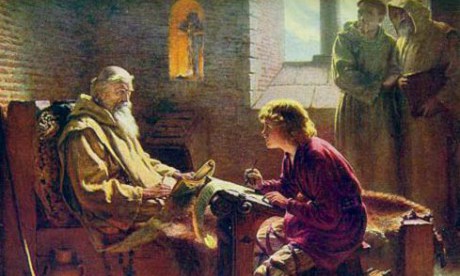Set among the call centres and storage facilities of Jarrow in the northeast of England is a farm, of sorts.
There are pigs, sheep and goats here. Some are ancient varieties, more popular 1,400 years ago than they are today.
Like a shaggy-haired pig described my guide, John Sadler, as “half a ton of very grumpy animal … only interested if you feed it, or if you fall in — in which case you are food.”
The animals are part of a re-creation of an Anglo-Saxon village, with timber-framed buildings and turf-covered sheds. The farm is called Gyrwe, Old English for Jarrow. It’s part of a museum called Bedesworld.
Even with jets flying overhead and container ships unloading nearby, Bede’s World brings to life a time and place when the English language was in its infancy.
The monk who Bede’s World is named after, the Venerable Bede, lived in the monastery next door in the late seventh and early eighth centuries.
“He’s famous as a writer and a teacher,” says Sadler, the living history coordinator at Bede’s World.
“And he has this keen interest in history and language.”
Bede wrote an ecclesiastical history of the nation at the time.
“He’s the first person to actually write down who it was that actually came to the British Isles,” says linguist David Crystal, co-author with Hilary Crystal of Wordsmiths and Warriors.
“He talks about the Angles and the Saxons and the Jutes, and discusses the range of languages that were spoken around the country.”
These languages arrived in Britain after the Romans had left.
The newcomers found themselves in a place already heaving with languages — various Celtic tongues, as well as bits and pieces of languages left behind by Roman mercenaries who came from all over the empire. Continue reading
Sources
- PRI
- Image: Vita pastoralis
News category: Features.




